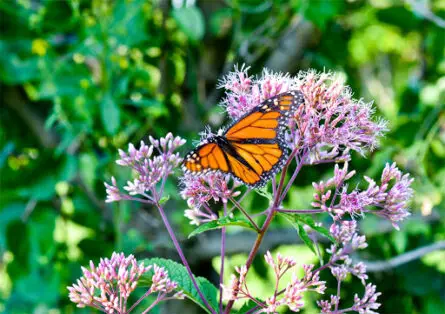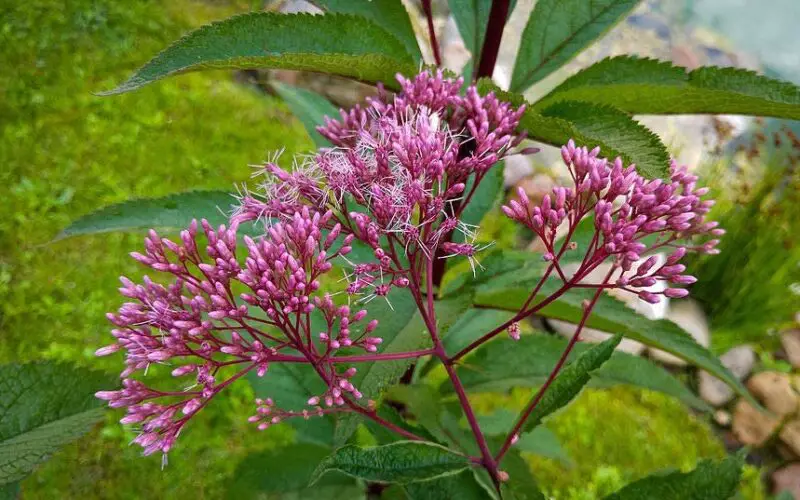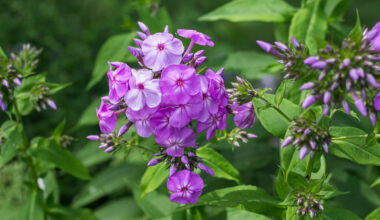The joe pye weed emerge from July to September. It is an excellent melliferous plant that attracts many pollinators (bees, butterflies …). It also ensures a beautiful transition between summer flowering plants and autumn flowering plants. Its umbrella-shaped flowers are generally pink, white, purple or carmine red.
Contents
Why you should care for the Joe Pye Weed ?
The Joe Pye Weed is one of the plants and flowers that particularly attract butterflies to the garden. These majestic insects, as light as they are graceful, also delight gardeners thanks to their role as pollinators.
Many species of plants, known as entomophiles, need insects to ensure their reproduction: as they move from flower to flower in search of nectar, these insects carry fertilizing pollen. Butterflies contribute largely to this, alongside bees in particular.
How to care for the Joe Pye weed ?
Easy to cultivate and very rustic, the joe pye weed is very greedy in water. Water it generously throughout the vegetation, as it quickly fades when it is without water.
Mulch with grass clippings to limit watering and keep the soil cool.
After flowering, remove wilted inflorescences and gently fold down stems and foliage to encourage new vegetation and flower growth.
Trim the dry clump when it is no longer decorative.
Bring in some compost or decomposed manure in early spring.
In a pot, bring a liquid fertilizer for flowering plants every May to September. Mulch the top of the pot. Repot in the spring.

How to plant the joe pye weed ?
The joe pye weed likes rather cool and humid climates as well as heavy and clayey, rather calcareous soils. However, it adapts easily to any ordinary soil, not too dry (in dry soil, the leaves take on a burnt aspect), in the sun or in half-shade.
In a pot, install it in a rich and fresh mixture (garden soil with peat and sand added) on a shady terrace.
By planting your joe pye weed on a bank, you will benefit from the humidity brought by the pond or the water that runs off. These conditions allow you to plant all year round (except during frosty periods). However, it will be necessary to follow the watering during the first year while the root system develops to draw water from below.
To plant the joe pye weed, it is necessary to make a planting hole of at least 3 to 5 times the volume of the pot. Remove the plastic pot and gently place the joe pye weed in the hole you have made. The planting depth must be respected, the top of the root ball of your plant must be at the level of the finished soil.
Fill up with the soil you took out before. Mulch with 1 inch of wood chip or straw (flax or hemp) to keep the humidity, enrich and balance your soil.
Put too deep the plant can rot. You can add soil or compost around the root ball. It is essential to water the plant well after planting by bringing 2 to 3 the volume of water compared to the volume of your planting hole.
Common Diseases and Parasites of the Joe Pye Weed
It is a plant rather sensitive to mildew, powdery mildew and rust.
These diseases which are all fungus leave traces on the leaves, it can be simple spots of brown, brown, black or white color.
It is advisable to treat with Bordeaux mixture as a preventive measure.
The other precaution to take is to avoid wetting the foliage when watering the joe pye weed.
Attention, the joe pye weed makes the happiness of slugs and snails.
Also watch out for red spiders and white flies.
Summary
The joe pye weed is a perennial plant that is cultivated for feathery corymbs and foliage on purple stems. It is a plant of full sun and half shade that grows in any well-drained but cool soil.
The bloom at the end of the summer and in autumn, from July to September, produces corymbs of small pink to dark pink feathery flower heads that grow at the top of the erect stem.
Its medium green foliage is made of oblong, oval, toothed and rough leaves that grow on the purple stems. They are plants that attract butterflies that are cultivated in flower beds. It must be folded once the bloom is finished.









